
Fulk FitzWarin, variant spellings, the third, was a prominent representative of a marcher family associated especially with estates in Shropshire and at Alveston in Gloucestershire. In young life, early in the reign of King John (1199–1216), he won notoriety as the outlawed leader of a roving force striving to recover his familial right to Whittington Castle in Shropshire, which John had granted away to a Welsh claimant. Progressively rehabilitated, and enjoying his lordship, he endured further setbacks in 1215–1217.

John Bourchier, 1st Baron Berners, KG was an English peer.
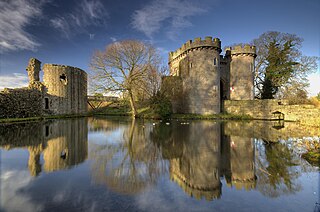
Whittington Castle is a castle in northern Shropshire, England, owned and managed by the Whittington Castle Preservation Fund. The castle was originally a motte-and-bailey castle, but this was replaced in the 13th century by one with buildings around a courtyard whose exterior wall was the curtain wall of the inner bailey. As a castle of the Welsh Marches, it was built on the border of Wales and England very close to the historic fort of Old Oswestry.

John Bourchier, 1st Earl of Bath was named Earl of Bath in 1536. He was feudal baron of Bampton in Devon.

John Bourchier, 2nd Earl of Bath was an Earl in the peerage of England. He also succeeded to the titles of 12th Baron FitzWarin, Baron Daubeney and 4th Count of Eu.

Edward Bourchier, 4th Earl of Bath.
Bourchier is an English surname, from French Boursier, keeper of the purse. Bourchier is the Norman pronunciation.

Fulk Bourchier, 10th Baron FitzWarin was the son and heir of William Bourchier, 9th Baron FitzWarin (1407–1470) and the father of John Bourchier, 1st Earl of Bath. He was feudal baron of Bampton in Devon.

James Audley, 2nd Baron Audley of Heighley Castle, Staffordshire, was an English peer. He was the son and heir of Nicholas Audley, 1st Baron Audley (1289–1316) by his wife Joan Martin, who was the daughter of William Martin, feudal baron of Barnstaple, and Marcher Lord of Kemes. She was posthumously the eventual sole heiress of her brother William FitzMartin to Barnstaple and Kemes.

William de Botreaux (1367–1395) was a baron prominent in South-West Britain.

From AD 1066, the feudal barony of Barnstaple was a large feudal barony with its caput at the town of Barnstaple in north Devon, England. It was one of eight feudal baronies in Devonshire which existed in the Middle Ages. In 1236 it comprised 56 knight's fees or individual member manors. The feudal service owed for half the barony in 1274 was the provision to the royal army of two knights or four sergeants for forty days per annum, later commuted to scutage.
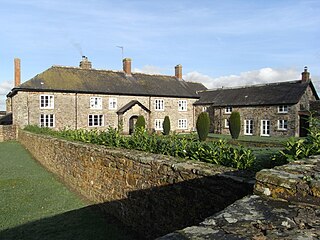
Brightley was historically the principal secondary estate within the parish and former manor of Chittlehampton in the county of Devon, England, situated about 2 1/4 miles south-west of the church and on a hillside above the River Taw. From the early 16th century to 1715 it was the seat of the Giffard family, whose mansion house occupied the moated site immediately to the west of the present large farmhouse known as Brightley Barton, a Grade II listed building which incorporates some elements of the earlier house. It is not to be confused with the 12th-century Brightley Priory near Okehampton.

Annery was an historic estate in the parish of Monkleigh, North Devon.

The feudal barony of Bampton was one of eight feudal baronies in Devonshire which existed during the mediaeval era, and had its caput at Bampton Castle within the manor of Bampton.

William Bourchier (1407–1470) jure uxoris 9th Baron FitzWarin, was an English nobleman. He was summoned to Parliament in 1448 as Baron FitzWarin in right of his wife Thomasine Hankford.
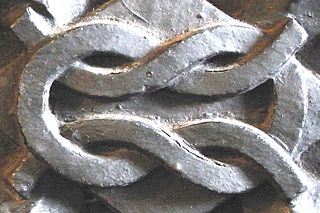
The Bourchier knot is a variety of heraldic knot. It was used as a heraldic badge by the Bourchier family, whose earliest prominent ancestor in England was John de Bourchier, a Judge of the Common Pleas, seated at Stanstead Hall in the parish of Halstead, Essex. He was the father of Robert Bourchier, 1st Baron Bourchier (d.1349), Lord Chancellor of England. The various branches of his descendants held the titles Baron Bourchier, Count of Eu, Viscount Bourchier, Earl of Essex, Baron Berners, Baron FitzWarin and Earl of Bath. The knot should perhaps have been called the "FitzWarin knot" as according to Boutell (1864) the device was first used by the FitzWarin family, whose heir was the Bourchier family.
Fulk I FitzWarin was a powerful marcher lord seated at Whittington Castle in Shropshire in England on the border with Wales, and also at Alveston in Gloucestershire. His grandson was Fulk III FitzWarin the subject of the famous mediaeval legend or "ancestral romance" entitled Fouke le Fitz Waryn, himself the grandfather of Fulk V FitzWarin, 1st Baron FitzWarin (1251-1315).
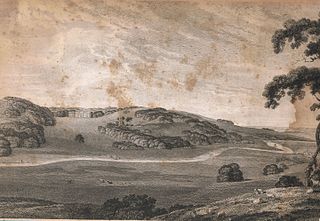
The historic manor of Tawstock was situated in North Devon, in the hundred of Fremington, 2 miles south of Barnstaple, England. According to Pole the feudal baron of Barnstaple Henry de Tracy made Tawstock his seat, apparently having abandoned Barnstaple Castle as the chief residence of the barony. Many of the historic lords of the manor are commemorated by monuments in St Peter's Church, the parish church of Tawstock which in the opinion of Pevsner contains "the best collection in the county apart from those in the cathedral", and in the opinion of Hoskins "contains the finest collection of monuments in Devon and one of the most notable in England".

Margaret II Audley was a co-heiress to the feudal barony of Barnstaple in Devon, England.
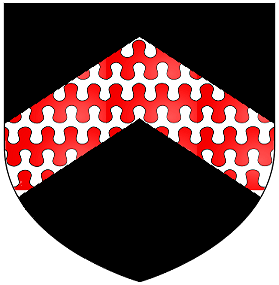
Sir Richard Hankford (1397-1431) was an English landowner and soldier from Devon.















